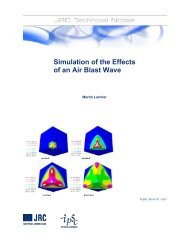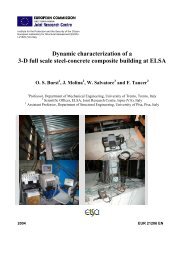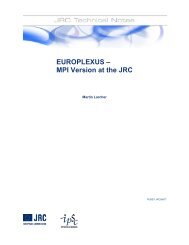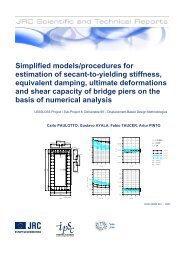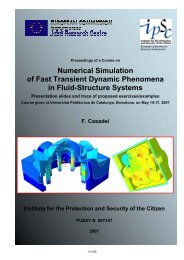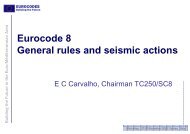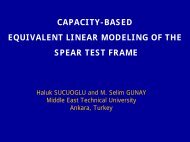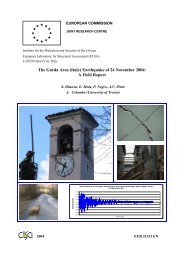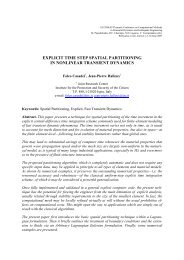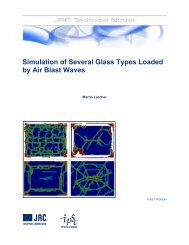Dynamic Effects on Culverts for High Speed Trains
Dynamic Effects on Culverts for High Speed Trains
Dynamic Effects on Culverts for High Speed Trains
You also want an ePaper? Increase the reach of your titles
YUMPU automatically turns print PDFs into web optimized ePapers that Google loves.
Workshop<strong>on</strong>“DYNAMICS, STRUCTURAL ANDEARTHQUAKE ENGINEERING:RESEARCH AND PRACTICE”at the occasi<strong>on</strong> ofProf. MICHEL GÉRADIN´s65th Anniversary andretirement from the JRC16 - july - 2010ENRIQUEALARCÓN
“<str<strong>on</strong>g>Dynamic</str<strong>on</strong>g>s, Structural and Earthquake Engineering:Research and Practice”<str<strong>on</strong>g>Dynamic</str<strong>on</strong>g> effects <strong>on</strong> culverts <strong>for</strong>high speed trainsE. Alarcón, J. Vega, E. M<strong>on</strong>tañés, A. FraileUniversidad Politécnica de Madrid16 - july - 2010ENRIQUEALARCÓN
“<str<strong>on</strong>g>Dynamic</str<strong>on</strong>g>s, Structural and Earthquake Engineering:Research and Practice”• Proliferati<strong>on</strong> of commercial high-speed lines• Variety of new “old “ problems.• Bridge res<strong>on</strong>ances produced not <strong>on</strong>ly by critical speeds but byrepeated excitati<strong>on</strong> by the axle loads.• Ballast liquefacti<strong>on</strong> due to high levels of vertical accelerati<strong>on</strong>• Deagregati<strong>on</strong> of embankments <strong>on</strong> soft soils due to wavestravelling to speeds near the train <strong>on</strong>e.• Vibrati<strong>on</strong> ( and sound!) transmitted to nearby buildings.16 - july - 2010ENRIQUEALARCÓN1. Foreword and objectives
“<str<strong>on</strong>g>Dynamic</str<strong>on</strong>g>s, Structural and Earthquake Engineering:Research and Practice”16 - july - 2010ENRIQUEALARCÓNRECTANGULAR BARREL DRAINPIPES VAULTS FRAMES2. Foreword and objectives
“<str<strong>on</strong>g>Dynamic</str<strong>on</strong>g>s, Structural and Earthquake Engineering:Research and Practice”CROSS -SECTION16 - july - 2010ENRIQUEALARCÓN2. Foreword and objectives
“<str<strong>on</strong>g>Dynamic</str<strong>on</strong>g>s, Structural and Earthquake Engineering:Research and Practice”MT: Layers of cemented mixedMG: Layers of granulated mixed str<strong>on</strong>gly compactedoverburden (0.70 m); abutment height (3 m)EMBANKMENT CROSS –SECTION16 - july - 2010ENRIQUEALARCÓN2. Foreword and objectives
“<str<strong>on</strong>g>Dynamic</str<strong>on</strong>g>s, Structural and Earthquake Engineering:Research and Practice”MG: Layers of granulated mixed str<strong>on</strong>gly compactedoverburden (3.12 m)EMBANKMENT CROSS –SECTION16 - july - 2010ENRIQUEALARCÓN2. Foreword and objectives
“<str<strong>on</strong>g>Dynamic</str<strong>on</strong>g>s, Structural and Earthquake Engineering:Research and Practice”In the framework of the new European Interoperability andCodificati<strong>on</strong> ef<strong>for</strong>t, a research has been launched whose mainaim is the producti<strong>on</strong> of computati<strong>on</strong>al models, AS SIMPLEAS POSSIBLE, giving acceptable results irrespective of thespeed of traffic and type of trains.16 - july - 2010ENRIQUEALARCÓN1. Foreword and objectives
“<str<strong>on</strong>g>Dynamic</str<strong>on</strong>g>s, Structural and Earthquake Engineering:Research and Practice”6 closed rectangular frames: 3 precast, 2 cast in situ and 1 mixed(precast abutments and in-situ slab)Several rectangular open frames, barrel vaults and drainpipesOverall sizes:Spans: 2 to 10 mClear height: 1.5 to 6.5 mOverburden: 0.6 to 3.0 m<strong>Trains</strong> (138 items):<strong>Speed</strong>: 100 to 300 km/hTalgo 350 (300 km/h)Talgo 250 (200 km/h)Altaria (200 km/h)ATPRD-CAF (200 km/h)16 - july - 2010ENRIQUEALARCÓN3. In-situ test campaign
“<str<strong>on</strong>g>Dynamic</str<strong>on</strong>g>s, Structural and Earthquake Engineering:Research and Practice”Track Drainpipe instrumentati<strong>on</strong>Frame Vault16 - july - 2010ENRIQUEALARCÓN3. In-situ test campaign
“<str<strong>on</strong>g>Dynamic</str<strong>on</strong>g>s, Structural and Earthquake Engineering:Research and Practice”16 - july - 2010ENRIQUEALARCÓN4. Numerical analysis and model updating
“<str<strong>on</strong>g>Dynamic</str<strong>on</strong>g>s, Structural and Earthquake Engineering:Research and Practice”• Transfer functi<strong>on</strong>• Harm<strong>on</strong>ic soluti<strong>on</strong>s (frequencies of interest)• Different damping <strong>for</strong> different materials• Frequency depending absorbing boundaries16 - july - 2010ENRIQUEALARCÓN4. Numerical analysis and model updating
“<str<strong>on</strong>g>Dynamic</str<strong>on</strong>g>s, Structural and Earthquake Engineering:Research and Practice”16 - july - 2010ENRIQUEALARCÓN4. Numerical analysis and model updating
“<str<strong>on</strong>g>Dynamic</str<strong>on</strong>g>s, Structural and Earthquake Engineering:Research and Practice”Parametric study <strong>for</strong> rectangular frames:• 3 span lengths: 3, 5 and 10 m• 3 values of overburden: 0.6, 1.5 and 3 m• 3 trains:• 26 speeds: 50 to 300 km/h, each 10 km/h• with and without rail irregularities1404 computati<strong>on</strong>s16 - july - 2010ENRIQUEALARCÓN5. Statistical studies and preliminary practical <strong>for</strong>mula
“<str<strong>on</strong>g>Dynamic</str<strong>on</strong>g>s, Structural and Earthquake Engineering:Research and Practice”Simplified design procedure-3 3T = 18·10 L OI. <str<strong>on</strong>g>Dynamic</str<strong>on</strong>g> factor <strong>on</strong> c<strong>on</strong>crete slabi. KKV · T2 · Lii.1+′K1 '=1+ 1-K+K4iii.Φ =δδstst UIC1+ '+ ''16 - july - 2010ENRIQUEALARCÓN
“<str<strong>on</strong>g>Dynamic</str<strong>on</strong>g>s, Structural and Earthquake Engineering:Research and Practice”16 - july - 2010ENRIQUEALARCÓN5. Statistical studies and preliminary practical <strong>for</strong>mula
“<str<strong>on</strong>g>Dynamic</str<strong>on</strong>g>s, Structural and Earthquake Engineering:Research and Practice”16 - july - 2010ENRIQUEALARCÓN
“<str<strong>on</strong>g>Dynamic</str<strong>on</strong>g>s, Structural and Earthquake Engineering:Research and Practice”Simplified design procedure2I. Maximum accelerati<strong>on</strong> a = C L V · T max m 2 · L ii. Ballast interface C = 40·10 4i. C<strong>on</strong>crete slab C = 15·10 416 - july - 2010ENRIQUEALARCÓN
“<str<strong>on</strong>g>Dynamic</str<strong>on</strong>g>s, Structural and Earthquake Engineering:Research and Practice”16 - july - 2010ENRIQUEALARCÓN
“<str<strong>on</strong>g>Dynamic</str<strong>on</strong>g>s, Structural and Earthquake Engineering:Research and Practice”Simplified design procedure:AOt .BL: span; V: train speed1. m: Mass per unit lengthA+Bm ct B + sO22. T: fundamental period1T = L O750.7 0.2516 - july - 2010ENRIQUEALARCÓN
“<str<strong>on</strong>g>Dynamic</str<strong>on</strong>g>s, Structural and Earthquake Engineering:Research and Practice”m rc hE c , A c , I c , ck h12 mk sm sc sk pm stpc p0.6 mASn ( ) ( B2 n)316 - july - 2010ENRIQUEALARCÓN
“<str<strong>on</strong>g>Dynamic</str<strong>on</strong>g>s, Structural and Earthquake Engineering:Research and Practice”16 - july - 2010ENRIQUEALARCÓN
“<str<strong>on</strong>g>Dynamic</str<strong>on</strong>g>s, Structural and Earthquake Engineering:Research and Practice”Slab Centre16 - july - 2010ENRIQUEALARCÓN5. Statistical studies and preliminary practical <strong>for</strong>mula
“<str<strong>on</strong>g>Dynamic</str<strong>on</strong>g>s, Structural and Earthquake Engineering:Research and Practice”T = 0.05 sT = 0.036 s16 - july - 2010ENRIQUEALARCÓN
“<str<strong>on</strong>g>Dynamic</str<strong>on</strong>g>s, Structural and Earthquake Engineering:Research and Practice”Some material properties16 - july - 2010ENRIQUEALARCÓN



